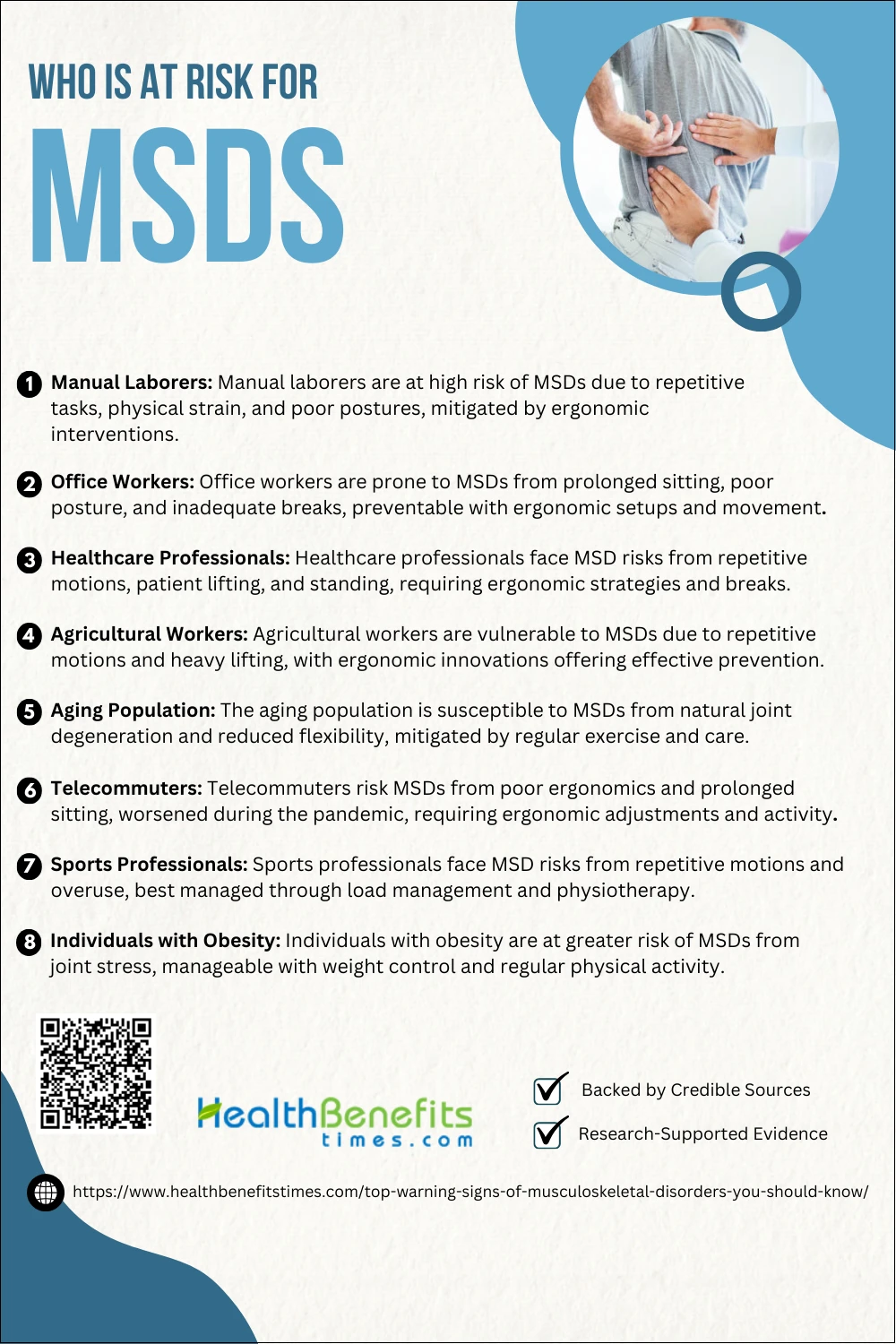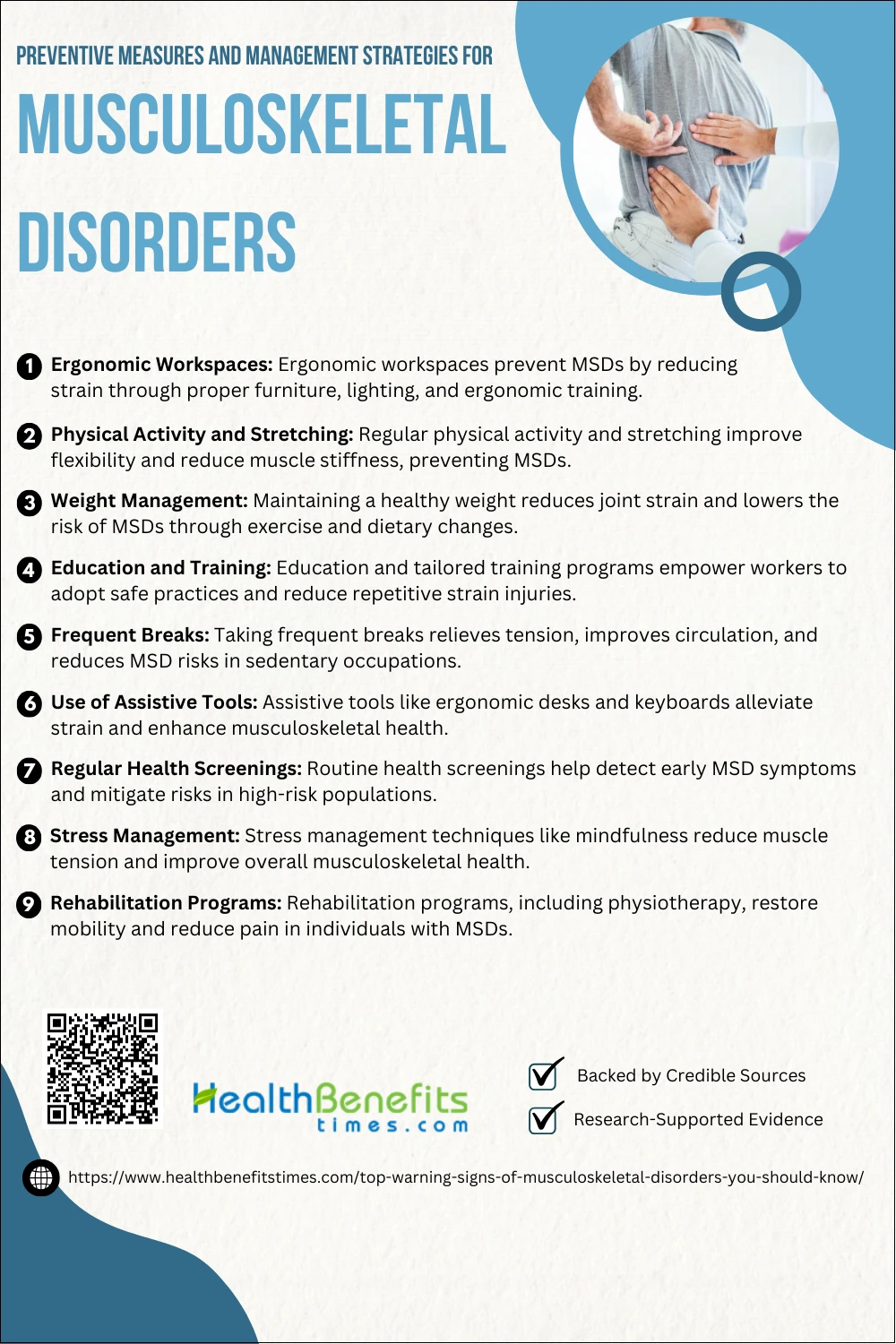- Conditions affecting muscles, joints, and bones that cause pain, stiffness, and limited mobility.
- Persistent pain, swelling, and restricted movement are key warning signs that shouldn’t be ignored.
- Early detection and proactive management can prevent complications and improve overall musculoskeletal health.
 Musculoskeletal disorders (MSDs) are conditions that impact the muscles, bones, tendons, ligaments, and surrounding tissues, leading to discomfort, restricted movement, or chronic pain (1). Millions of people worldwide suffer from musculoskeletal disorders, which are a leading cause of disability and reduced quality of life. From the office worker grappling with carpal tunnel syndrome to the elderly individual struggling with osteoporosis, these disorders can strike anyone at any age (2). Often triggered by repetitive stress, poor posture, or aging, MSDs may initially present with subtle symptoms, such as mild stiffness or discomfort. However, these early signs can quickly escalate into debilitating conditions without proper attention (3). Recognizing the warning signs, such as persistent pain, swelling, or tingling sensations, is vital to preventing long-term complications (4). As the prevalence of MSDs rises, understanding their causes and symptoms is critical for effective management and prevention (5).
Musculoskeletal disorders (MSDs) are conditions that impact the muscles, bones, tendons, ligaments, and surrounding tissues, leading to discomfort, restricted movement, or chronic pain (1). Millions of people worldwide suffer from musculoskeletal disorders, which are a leading cause of disability and reduced quality of life. From the office worker grappling with carpal tunnel syndrome to the elderly individual struggling with osteoporosis, these disorders can strike anyone at any age (2). Often triggered by repetitive stress, poor posture, or aging, MSDs may initially present with subtle symptoms, such as mild stiffness or discomfort. However, these early signs can quickly escalate into debilitating conditions without proper attention (3). Recognizing the warning signs, such as persistent pain, swelling, or tingling sensations, is vital to preventing long-term complications (4). As the prevalence of MSDs rises, understanding their causes and symptoms is critical for effective management and prevention (5).
Understanding Musculoskeletal Disorders
Musculoskeletal disorders (MSDs) are conditions affecting muscles, bones, tendons, ligaments, and surrounding tissues, leading to pain, stiffness, and functional limitations (1). These disorders range from mild discomfort to severe chronic pain, impacting everyday activities.
MSDs often stem from repetitive strain, poor posture, aging, or occupational hazards (6). Common examples include arthritis, back pain, carpal tunnel syndrome, and tendinitis (7). Improper ergonomic practices at workplaces are a significant contributing factor (8).
MSDs are among the leading causes of disability globally, affecting millions and reducing productivity (9). They significantly lower the quality of life, particularly among the elderly and individuals in physically demanding jobs (10).
Top Warning Signs of Musculoskeletal Disorders
Musculoskeletal disorders (MSDs) can severely impact daily life. Recognizing early warning signs helps prevent chronic pain, limited mobility, and disability.
 1. Pain and Discomfort
1. Pain and Discomfort
Pain and discomfort are hallmark signs of musculoskeletal disorders, ranging from localized joint tenderness to widespread muscle pain. These symptoms often result from overuse, injuries, or chronic conditions like arthritis (11). Early rehabilitation and targeted therapy significantly mitigate pain progression (12). Inflammatory conditions such as sacroiliitis exemplify the importance of early diagnosis (13). Persistent discomfort, if ignored, may lead to systemic complications and reduced quality of life (14). Understanding pain patterns enhances timely interventions (15).
2. Stiffness and Limited Mobility
Stiffness and limited mobility are common warning signs of musculoskeletal disorders, often stemming from conditions such as osteoarthritis, which impairs joint flexibility (16). Persistent stiffness in the hips or knees may indicate early-onset degenerative diseases (17). Factors such as aging and poor posture exacerbate these symptoms (18). Early intervention with physical therapy can significantly improve mobility and reduce progression.
3. Swelling and Inflammation
Swelling and inflammation are critical indicators of musculoskeletal disorders, often stemming from chronic conditions like rheumatoid arthritis (11). These symptoms result from inflammatory responses in affected tissues, leading to pain and reduced mobility (13). Edema and joint stiffness are common in severe cases of sacroiliitis and similar disorders (19). Chronic inflammation can also worsen existing degenerative conditions, accelerating tissue damage (16).
4. Limited Range of Motion
Limited range of motion is a significant indicator of musculoskeletal disorders, often stemming from joint stiffness, inflammation, or injuries (20). This symptom can severely impact daily activities and reduce mobility if untreated (12). Chronic conditions like osteoarthritis or tendonitis commonly lead to motion restrictions (21). Early rehabilitation and therapeutic interventions are essential for preventing long-term complications (22). Maintaining flexibility through physical activity is also vital (23).
5. Weakness or Fatigue
Weakness or fatigue is a common early symptom of musculoskeletal disorders, often linked to chronic conditions like myasthenia gravis or inflammatory myopathies (24). This symptom occurs due to impaired muscle function or systemic inflammation (25). Studies show that muscle weakness can be exacerbated by poor energy management in skeletal tissues (26). Early diagnosis and treatment, including physical therapy, can help improve strength and reduce fatigue (27). Lifestyle modifications also play a crucial role in managing these symptoms (28).
6. Numbness or Tingling
Numbness or tingling is a significant indicator of musculoskeletal disorders, commonly resulting from nerve compression or inflammation, as seen in conditions like carpal tunnel syndrome. These sensations often occur in the hands, feet, or arms and may signal underlying spinal or nerve issues (29). Prolonged symptoms can lead to weakness or atrophy if left untreated (30). Early intervention, such as physical therapy or ergonomic adjustments, helps alleviate symptoms (31). Addressing ergonomic risks is crucial for prevention (32).
7. Deformities or Abnormal Postures
Deformities or abnormal postures, such as scoliosis or kyphosis, often signify underlying musculoskeletal disorders. These conditions may stem from congenital anomalies or prolonged poor ergonomics (33). Abnormal postures, if unaddressed, can lead to chronic pain and reduced functionality (34). Regular ergonomic assessments are essential for prevention (35). Early diagnosis ensures better outcomes and reduces disability (36).
8. Difficulty Performing Daily Activities
Difficulty performing daily activities, such as walking, lifting, or climbing stairs, often signifies musculoskeletal disorders like arthritis or tendinitis (19). Such limitations stem from chronic pain, stiffness, or weakness (37). If untreated, these challenges can lead to long-term disability (38). Early diagnosis and physical therapy can mitigate symptoms and improve quality of life (39).
9. Clicking, Popping, or Grinding Sounds
Clicking, popping, or grinding sounds in joints, also known as crepitus, are common signs of musculoskeletal disorders like osteoarthritis or tendonitis (40). These sounds often occur due to joint misalignment or cartilage wear (41). Early intervention, such as physical therapy, can help restore joint function (42). Diagnostic imaging like MRIs is often used to identify underlying causes (43).
Who Is at Risk for MSDs?
Musculoskeletal disorders (MSDs) can affect anyone but are more common in certain groups. Identifying risk factors helps with prevention.
 1. Manual Laborers
1. Manual Laborers
Manual laborers are at high risk for musculoskeletal disorders (MSDs) due to repetitive tasks, awkward postures, and physical strain (44). These activities often cause joint stress and muscle fatigue, particularly in industries such as agriculture and manufacturing (45). Implementing ergonomic interventions can significantly reduce their risk (46).
2. Office Workers
Office workers are at risk for musculoskeletal disorders (MSDs) due to prolonged sitting, poor posture, and improper workstation ergonomics (47). Repeated strain from typing and inadequate breaks further exacerbate risks (48). Preventative measures, such as ergonomic interventions and regular movement, significantly reduce MSD prevalence (49).
3. Healthcare Professionals
Healthcare professionals face significant risks of musculoskeletal disorders due to repetitive motions, lifting patients, and prolonged standing (48). These occupational demands frequently lead to chronic pain and joint fatigue (50). Implementing ergonomic strategies and regular breaks can significantly reduce MSD prevalence in this high-risk group (51).
4. Agricultural Workers
Agricultural workers face elevated risks for musculoskeletal disorders due to repetitive motions, awkward postures, and heavy lifting during harvesting and planting (52). These physical demands often lead to chronic pain and joint strain (45). Ergonomic innovations can reduce these occupational hazards significantly (53).
5. Aging Population
The aging population is highly susceptible to musculoskeletal disorders due to natural joint degeneration, decreased muscle mass, and reduced flexibility (54). Osteoarthritis and osteoporosis are common among older adults, limiting mobility and independence (55). Regular physical activity and preventive care are essential for mitigating these risks (56).
6. Telecommuters
Telecommuters are increasingly at risk for musculoskeletal disorders (MSDs) due to poor workstation ergonomics, prolonged sitting, and inadequate physical activity (57). The COVID-19 pandemic has amplified these risks by increasing remote work hours (58). Addressing ergonomic and psychosocial factors is essential for prevention (59).
7. Sports Professionals
Sports professionals face a heightened risk of musculoskeletal disorders (MSDs) due to repetitive motions, overuse injuries, and biomechanical stress during high-intensity activities (60). Tennis players, for example, often develop MSDs from serving mechanics (61). Preventive strategies like load management and physiotherapy are crucial for reducing injuries.
8. Individuals with Obesity
Individuals with obesity are at increased risk for musculoskeletal disorders due to added stress on joints and soft tissues (52). This extra strain contributes to conditions like osteoarthritis and chronic back pain (62). Weight management and regular exercise are crucial preventive measures (57).
Importance of Early Detection and Diagnosis
Early detection and diagnosis are crucial for effective treatment, preventing complications, and improving outcomes in managing health conditions.
- Improved Treatment Outcomes
Early detection significantly boosts the success of treatments, particularly for progressive diseases like cancer or cardiovascular disorders. Timely intervention prevents disease progression, increases the chances of remission, and often enables less invasive treatment options (63). - Reduced Healthcare Costs
Catching diseases in their initial stages reduces the need for expensive, advanced treatments required in later stages. Preventive care and early therapies are often more cost-effective, benefiting both patients and healthcare systems (64). - Increased Survival Rates
Conditions like cancer or heart disease, when detected early, often have significantly higher survival rates. For instance, early-stage cancer diagnosis can lead to a survival rate of over 90%, compared to late-stage detection, where survival may drop drastically (65). - Minimized Complications
Detecting conditions early helps avoid complications that arise from untreated or poorly managed diseases. For example, early identification of diabetes can prevent severe complications like neuropathy or cardiovascular issues (66). - Better Quality of Life
Early diagnosis and management can alleviate symptoms, slow disease progression, and allow individuals to maintain their normal routines. For chronic conditions, early treatment often delays the onset of debilitating symptoms (67). - Enhanced Predictive Models
Data collected from early diagnostics aids in building predictive healthcare models. These models guide researchers and clinicians to forecast trends, improve treatment strategies, and develop new therapeutic interventions (68). - Preventative Measures
Early detection identifies individuals at risk, enabling targeted preventive interventions such as lifestyle changes, vaccinations, or dietary adjustments. For example, early osteoporosis diagnosis can lead to preventive care that avoids fractures (69). - Improved Public Health Management
Early detection is vital in managing contagious diseases or pandemics. It enables health authorities to monitor outbreaks, implement timely interventions, and reduce the spread of diseases, as seen during COVID-19 (70).
When to Seek Medical Advice
Recognizing when to seek medical advice is crucial for maintaining health and preventing complications. Persistent symptoms, unexplained pain, or sudden changes in well-being warrant immediate attention. Ignoring warning signs often leads to delayed diagnoses and poorer outcomes (71). Consulting healthcare providers early ensures timely treatment and reduces risks (63). Reliable medical guidance empowers individuals to manage their conditions effectively (66).
Preventive Measures and Management Strategies for Musculoskeletal disorders
Preventing musculoskeletal disorders (MSDs) involves proactive measures like proper ergonomics, exercise, and healthy habits to reduce risks and enhance mobility.
1. Ergonomic Workspaces
Ergonomic workspaces are essential for preventing musculoskeletal disorders (MSDs), reducing strain from improper postures and repetitive motions (72). Adjustable furniture, proper lighting, and well-designed tools enhance comfort and efficiency (73). Providing ergonomic training ensures long-term health benefits (32).
2. Physical Activity and Stretching
Physical activity and stretching are vital for preventing musculoskeletal disorders (MSDs), enhancing flexibility and reducing muscle stiffness (74). Regular stretching lowers the risk of work-related MSDs, particularly in sedentary occupations (75). Ergonomic interventions combined with stretching further improve outcomes (76).
3. Weight Management
Weight management is crucial for reducing musculoskeletal strain, particularly on load-bearing joints, lowering the risk of conditions like osteoarthritis (21). Maintaining a healthy BMI helps prevent inflammation and degenerative changes in connective tissues. Regular exercise combined with dietary changes ensures sustainable weight control and reduces MSD prevalence (77).
4. Education and Training
Education and training empower workers to adopt safe postures, reduce MSD risks, and improve task ergonomics (78). Utilizing advanced technologies like NLP enhances workplace safety (79). Tailored training programs significantly reduce repetitive strain injuries (80).
5. Frequent Breaks
Frequent breaks reduce musculoskeletal strain and prevent repetitive stress injuries, especially in sedentary jobs (74). Incorporating short pauses improves circulation and relieves tension, crucial for maintaining musculoskeletal health (81). Structured break schedules in high-risk occupations significantly lower MSD risks (82).
6. Use of Assistive Tools
Assistive tools like ergonomic keyboards, adjustable desks, and exoskeletons help alleviate physical strain and prevent MSDs (83). These devices improve workplace ergonomics and reduce repetitive stress injuries (84). Integrating these tools into daily tasks promotes musculoskeletal health (85).
7. Regular Health Screenings
Regular health screenings are essential for identifying early symptoms of musculoskeletal disorders (MSDs), enabling timely intervention and prevention of complications (82). Routine assessments in high-risk populations mitigate workplace-related MSDs (86). Screening programs improve occupational health by addressing ergonomic risks and monitoring musculoskeletal health (87).
8. Stress Management
Stress management is vital in mitigating musculoskeletal disorders (MSDs) by reducing muscle tension and improving mental health (72). Techniques such as mindfulness and relaxation training alleviate workplace stress, minimizing MSD risks (58). Comprehensive stress-reduction programs enhance overall musculoskeletal health (11).
9. Rehabilitation Programs
Rehabilitation programs play a critical role in managing musculoskeletal disorders by restoring mobility and reducing pain (72). These programs, including physiotherapy and occupational therapy, aid in regaining functional independence (82).
Conclusion
Recognizing the top warning signs of musculoskeletal disorders (MSDs) is essential for maintaining your health and well-being. Early symptoms like persistent pain, stiffness, swelling, and limited mobility should not be ignored, as timely intervention can prevent complications and improve your quality of life. By understanding these signs and seeking professional medical advice when needed, you can take proactive steps to manage or even prevent MSDs. Incorporating preventive measures, such as maintaining proper posture, staying active, and addressing ergonomic risks, further supports musculoskeletal health. Prioritizing awareness and early action empowers you to stay active and pain-free in the long run.
References:
- Centers for Disease Control and Prevention (CDC). Understanding Musculoskeletal Disorders.
- Prognostic Reasoning in Musculoskeletal Disorders.
- Risk Factors for Musculoskeletal Disorders.
- Patient Perspectives on Low Back Pain.
- Depression and Anxiety in Patients with MSDs.
- Fibromyalgia and Musculoskeletal Pain.
- Impact of MSDs on Life Quality.
- BMC Musculoskeletal Disorders. Occupational Factors in MSDs.
- Prevalence and Disability from MSDs.
- MSDs in Workplace Studies.
- Herbal Formulations in Arthritis.
- Electrotherapy in Rehabilitation.
- Oxford Academic. Infectious Sacroiliitis.
- Thoracic Vertebral Complications.
- SAGE Journals. Chronic Musculoskeletal Pain.
- Knee Osteoarthritis and Mobility Issues.
- Post-COVID Musculoskeletal Impact.
- Risk Factors and Postural Contributions.
- Edema and Joint Stiffness.
- Osteochondroma Identification and Diagnosis.
- Frontiers in Cell. Intervertebral Disc Degeneration.
- Ethical Issues in Musculoskeletal Treatment.
- Flexion Deformity in Arthritis.
- Late-Onset Pompe’s Disease Case Study.
- Charcot-Marie-Tooth and Muscle Weakness.
- ClC-1 Chloride Channel Studies.
- KI Archive. Exercise and Muscle Impairment in Myopathies.
- Sleep and Muscle Function in Neuromuscular Disorders.
- Red Flags in Diagnosis.
- Musculoskeletal Disorders: A Systems Approach.
- Median Nerve Symptoms and Diagnosis.
- Ergonomic Risks and Nerve Compression.
- Impact of Hand Grip Strength on Posture.
- Abnormal Spinal Postures.
- Ergonomics and Postural Health.
- Musculoskeletal Disorders in Abnormal Postures.
- Exploration Pub. Digital Technologies in Rheumatology.
- Long-Term Disability in MSDs.
- Physical Therapy for Activity Improvement.
- Crepitus and Joint Disorders.
- Signs of Chronic Pain in Joints.
- Dental Manifestations of Joint Issues.
- De Gruyter. Diagnostic Tools for Joint Sounds.
- Ergonomic Risk Assessment in Manual Laborers.
- Ergonomic Innovations in Agriculture.
- Manual Handling Risks in Construction.
- Ergonomic Challenges for Office Workers.
- Comparative Study on MSD Prevalence.
- PJ Public Health. Musculoskeletal Risks in Health Offices.
- Advances in Healthcare Ergonomics.
- UTU Journal. Occupational Factors in MSDs.
- Egyptian Journal. Prevalence of MSDs Among Agricultural Workers.
- UNEJ Repository. Musculoskeletal Challenges in Farming.
- Frontiers in Medicine. Prevalence of Musculoskeletal Pain in Aging Adults.
- Journal of Health Research. MSDs in Older Adults.
- SEHATMAS Journal. Preventive Care for Aging Populations.
- Musculoskeletal Disorders in Telecommuters.
- Frontiers in Psychology. Impact of Remote Work on MSDs.
- KNE Publishing. Telework and Work-Related MSDs.
- Musculoskeletal Risk in Tennis Players.
- MSDs in eSports Athletes.
- Insights-JHR. Obesity and Chronic Pain.
- Early Detection in Cancer Diagnosis.
- Reducing Healthcare Burdens with Early Diagnosis.
- Survival Benefits of Early Diagnosis.
- Role of Technology in Early Detection.
- Asthma Detection Advancements.
- Predictive Healthcare Models.
- Preventative Measures in Healthcare.
- Public Health Strategies.
- Delays in Medical Diagnoses.
- Ergonomic Awareness and MSD Prevention.
- Impact of Ergonomics on Workplace Health.
- Semantic Scholar. Stretching Exercises for MSD Prevention.
- Effectiveness of Stretching Programs.
- Stretching and Ergonomic Benefits.
- Exercise and Dietary Strategies for MSD Prevention.
- Importance of Worker Training for MSD Prevention.
- Taylor & Francis. NLP in Ergonomics and Safety Training.
- Customized Training for Industrial Workers.
- Workplace Ergonomics and Injury Prevention.
- Effectiveness of Structured Breaks for MSD Prevention.
- Systematic Review on MSD Management.
- Ergonomic Interventions for MSDs.
- Occupational MSD Prevention Strategies.
- Routine Assessments for MSD Prevention.
- Ergonomic Risk Monitoring.


